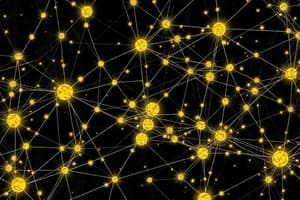Podcast
Questions and Answers
What is a characteristic of half-duplex mode?
What is a characteristic of half-duplex mode?
- Uses the entire capacity of the channel for each direction (correct)
- Allows simultaneous communication in both directions
- Is the fastest mode for data transmission
- Only works for one direction at a time
Half-duplex mode enables communication in both directions at the same time.
Half-duplex mode enables communication in both directions at the same time.
False (B)
In what situations is half-duplex mode typically used?
In what situations is half-duplex mode typically used?
When simultaneous communication in both directions is not required.
What is a primary characteristic of a mesh topology?
What is a primary characteristic of a mesh topology?
In half-duplex communication, the entire capacity of the channel can be utilized for each __________.
In half-duplex communication, the entire capacity of the channel can be utilized for each __________.
A mesh topology can become incapacitated if one link becomes unusable.
A mesh topology can become incapacitated if one link becomes unusable.
Match the modes of communication with their characteristics:
Match the modes of communication with their characteristics:
What advantage does a mesh topology offer regarding privacy or security?
What advantage does a mesh topology offer regarding privacy or security?
One of the benefits of a mesh topology is its robustness, meaning that if one link becomes unusable, it does not __________ the entire system.
One of the benefits of a mesh topology is its robustness, meaning that if one link becomes unusable, it does not __________ the entire system.
Match the following characteristics with their descriptions:
Match the following characteristics with their descriptions:
What describes a drop line in a bus topology?
What describes a drop line in a bus topology?
In a mesh topology, all nodes are directly connected to every other node.
In a mesh topology, all nodes are directly connected to every other node.
What topology uses a main cable to which all nodes are connected?
What topology uses a main cable to which all nodes are connected?
In a bus topology, nodes connect to the bus cable via __________.
In a bus topology, nodes connect to the bus cable via __________.
Match the following terms with their descriptions:
Match the following terms with their descriptions:
What is the typical ownership status of a Local Area Network (LAN)?
What is the typical ownership status of a Local Area Network (LAN)?
A Local Area Network (LAN) can connect devices across several cities.
A Local Area Network (LAN) can connect devices across several cities.
What is the maximum typical size of a LAN?
What is the maximum typical size of a LAN?
A Local Area Network (LAN) connects devices in a _______.
A Local Area Network (LAN) connects devices in a _______.
Match the following characteristics with Local Area Networks (LAN):
Match the following characteristics with Local Area Networks (LAN):
What does layer x on one machine do in relation to layer x on another machine?
What does layer x on one machine do in relation to layer x on another machine?
Data are directly transferred from layer n on one machine to layer n on another machine.
Data are directly transferred from layer n on one machine to layer n on another machine.
What type of address is used for communication with one specific recipient?
What type of address is used for communication with one specific recipient?
What type of communication occurs between corresponding layers on different machines?
What type of communication occurs between corresponding layers on different machines?
Between machines, layer x logically communicates with layer x on another machine, rather than directly transferring __________.
Between machines, layer x logically communicates with layer x on another machine, rather than directly transferring __________.
Multicast addresses can be used to target all systems on a network.
Multicast addresses can be used to target all systems on a network.
Match the following layers with their corresponding description of communication:
Match the following layers with their corresponding description of communication:
Define a broadcast address.
Define a broadcast address.
A __________ address is used to send data to multiple specified recipients only.
A __________ address is used to send data to multiple specified recipients only.
Match the following types of addresses with their descriptions:
Match the following types of addresses with their descriptions:
Flashcards
Half-duplex mode
Half-duplex mode
A method of communication where only one device can transmit at a time, allowing full channel capacity for each direction.
Full duplex
Full duplex
The ability of a communication channel to handle data in both directions simultaneously.
Channel capacity
Channel capacity
The total amount of data that a communication channel can transmit per unit of time.
Communication
Communication
Signup and view all the flashcards
Communication channel
Communication channel
Signup and view all the flashcards
Mesh Topology
Mesh Topology
Signup and view all the flashcards
Bus Topology
Bus Topology
Signup and view all the flashcards
Robustness
Robustness
Signup and view all the flashcards
Drop Line
Drop Line
Signup and view all the flashcards
Tap
Tap
Signup and view all the flashcards
Privacy or Security
Privacy or Security
Signup and view all the flashcards
Redundant Paths
Redundant Paths
Signup and view all the flashcards
Scalability
Scalability
Signup and view all the flashcards
What is a Local Area Network (LAN)?
What is a Local Area Network (LAN)?
Signup and view all the flashcards
What's the typical size of a LAN?
What's the typical size of a LAN?
Signup and view all the flashcards
What are some common uses for LANs?
What are some common uses for LANs?
Signup and view all the flashcards
How do devices connect to a LAN?
How do devices connect to a LAN?
Signup and view all the flashcards
How are LANs configured?
How are LANs configured?
Signup and view all the flashcards
Unicast Address
Unicast Address
Signup and view all the flashcards
Multicast Address
Multicast Address
Signup and view all the flashcards
Broadcast Address
Broadcast Address
Signup and view all the flashcards
Broadcast Address Limitations
Broadcast Address Limitations
Signup and view all the flashcards
Logical communication between layers
Logical communication between layers
Signup and view all the flashcards
Direct data transfer between layers on different machines
Direct data transfer between layers on different machines
Signup and view all the flashcards
Layer-to-layer communication across machines
Layer-to-layer communication across machines
Signup and view all the flashcards
Underlying processes for inter-machine communication
Underlying processes for inter-machine communication
Signup and view all the flashcards
Role of layers in inter-machine communication
Role of layers in inter-machine communication
Signup and view all the flashcards
Study Notes
Computer Networks Fundamentals
- The computer network is a collection of autonomous computers interconnected via a single technology. Two computers are interconnected if they can exchange information.
- Early computer networks were limited to exchanging text-based information. Current networks carry voice, video, text, and graphics, connecting various devices.
- Business applications use computer networks by having company data stored on servers, and employees access it remotely using client devices.
- In a client-server model, the client device requests information, and the server device responds.
- Home applications primarily use the Internet for connectivity to remote computers.
- Peer-to-peer networks allow computers to connect and share resources without a dedicated server. Each device can act as both a client and a server in this model.
- Mobile users utilize networks for connectivity to remote computers to access information.
Uses of Computer Networks
- Early data networks were limited to exchanging character-based information between connected computer systems.
- Modern networks carry voice, video streams, text, and graphics.
- They connect a wide variety of devices, including traditional company systems.
- Home networking has become popular. Mobile devices, and social issues are also important aspects.
Home Applications
- Internet access is used to connect home users to remote computers.
- A common model is the client server model for information access
- Peer-to-peer communication is another popular method for accessing information.
Mobile Users
- Mobile users frequently use their mobile devices for internet access.
- Wired connections are not practical in many mobile situations.
Social Issues
- Social networks allow people to share views with like-minded others, which can involve problematic issues such as copyright, cookies, and spam.
Networks
- A network is a collection of devices connected by communication links.
- Devices can be computers, printers, etc.
- Networks use distributed processing where tasks are divided among multiple computers instead of a large central machine.
The Elements of Computer Networks
- Devices, medium, rules, and messages.
- Common network devices include desktop computers, laptops, servers, switches, firewalls, routers, wireless routers, etc.
Data Flow
- Communication methods between devices can be simplex, half-duplex, or full-duplex.
- Simplex is one-way communication.
- Half-duplex is two-way communication, but not simultaneously.
- Full-duplex is two-way communication simultaneously.
Network Criteria
- Performance - measured by transit time, response time, throughput, and delay.
- Reliability - Measured by the frequency of failure, the time to recover, and the robustness against disasters.
- Security - protecting data from unauthorized access, damage, and breaches.
Categories of Networks
- Connection type—point-to-point (dedicated link) and multipoint (shared channel)
- Topology—mesh, bus, star, ring, and hybrid
- Distance—personal area networks (PANs), local area networks (LANs), metropolitan area networks (MANs), and wide area networks (WANs).
OSI Model
- A layered framework to design network systems that allows them to communicate with each other irrespective of architecture.
- Protocols are required for communication
- The framework is a model that allows data communication and networking to work together to move data from one device to another.
TCP/IP Protocol Suite
- A layered protocol model for internetwork communications.
- Defines four categories of functions necessary for successful communications.
- Has the same structure of the OSI model
- Built upon hardware
Addressing
- Four addressing levels in TCP/IP protocols: physical address, logical address, port address, and application-specific address.
- Physical addresses are unique to each device on a network.
- Logical addresses are independent of the underlying physical network.
- Port addresses are used to label the different processes on a computer.
Studying That Suits You
Use AI to generate personalized quizzes and flashcards to suit your learning preferences.




